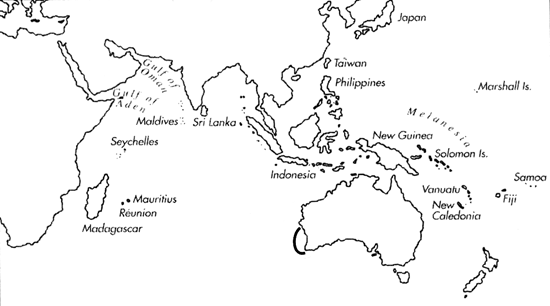Range: W. Australia from the Albany area to Jurien Bay.
Description: Usually moderately small and moderately light. Last whorl usually conical, sometimes ventricosely conical or broadly conical to broadly and ventricosely conical; outline convex at adapical fourth to third, almost straight below; left side constricted above base. Shoulder broadly carinate. Spire of low to moderate height, outline nearly straight. Larval shell of 1.5- 1.75 whorls, maximum diameter 1.1-1.2 mm. Teleoconch sutural ramps convex, with 0-2 increasing to 4 major spiral grooves; 1-2 intervening ribs often located high on sutural ramps. Last whorl with weak to distinct, well separated spiral grooves at base; ribbons between grade to ribs at anterior end.
| Shell Morphometry | ||
|---|---|---|
| L | 23-38 mm | |
| RW | 0.06-0.11 g/mm | |
| RD | 0.64-0.71 | |
| PMD | 0.84-0.88 | |
| RSH | 0.09-0.16 | |
Ground colour white. Last whorl with well separated spiral rows of alternating white and orange bars and with fusing orange clouds and spiral bands. Pattern may cover entire last whorl evenly or leave a spiral ground-colour band below centre and somewhat above base. Larval whorls white. Postnuclear sutural ramps with orange radial markings. Aperture translucent to white.
Periostracum thin and translucent.
Habitat and Habits: In 120-230 m.
Discussion: C. gabelishi may be similar in pattern to specimens of C. cocceus. The latter species can be distinguished by its more ventricose or ovate last whorl (PMD 0.71-0.85), generally higher and convex spire (RSH 0.13-0.22), and in its less distinct shoulder.

C. gabelishi range map
This section contains verbatim reproductions of the accounts of 316 species of Conus from the Indo-Pacific region, from Manual of the Living Conidae, by Röckel, Korn and Kohn (1995). They are reproduced with the kind permission of the present publisher, Conchbooks.
All plates and figures referred to in the text are also in Röckel, Korn & Kohn, 1995. Manual of the Living Conidae Vol. 1: Indo-Pacific Region.
The range maps have been modified so that each species account has it own map, rather than one map that showed the ranges of several species in the original work. This was necessary because each species account is on a separate page on the website and not confined to the order of accounts in the book.